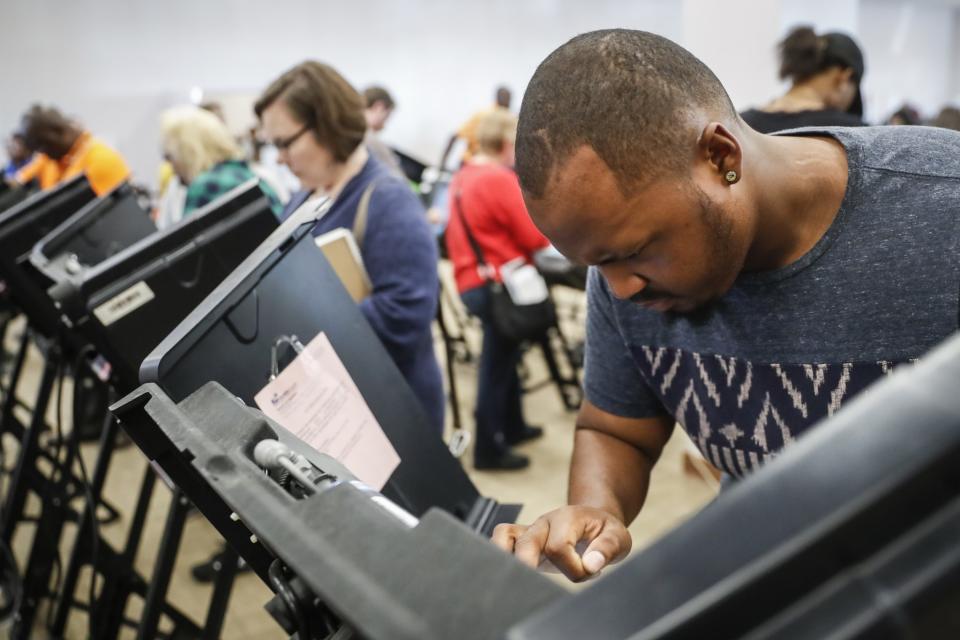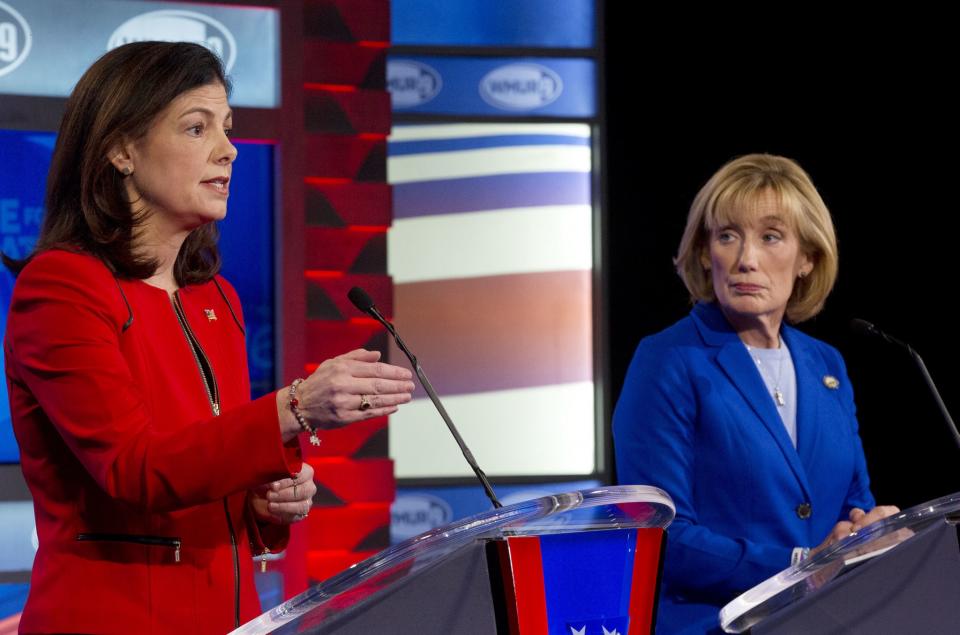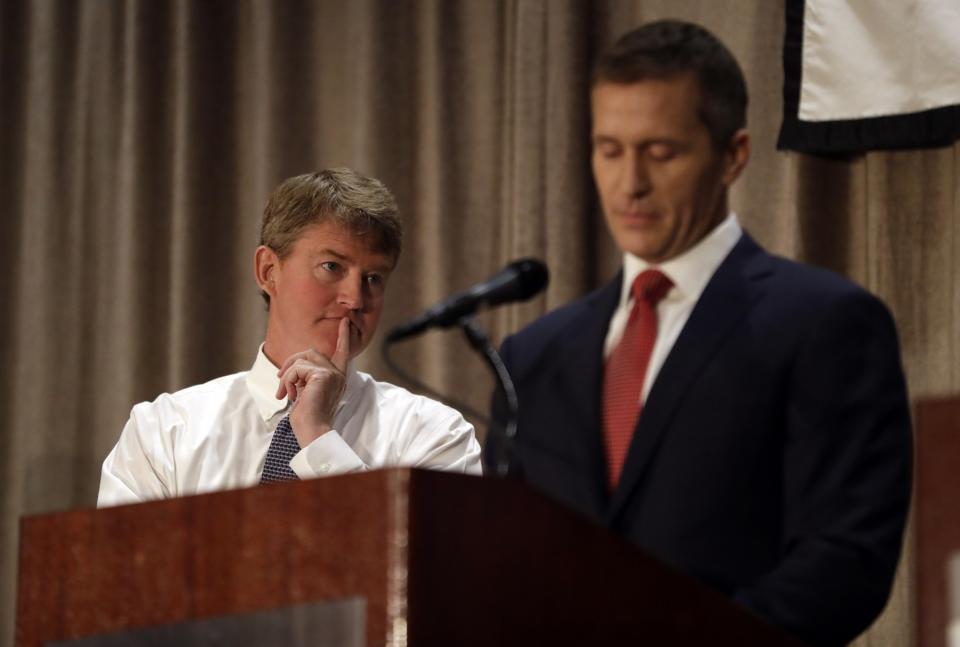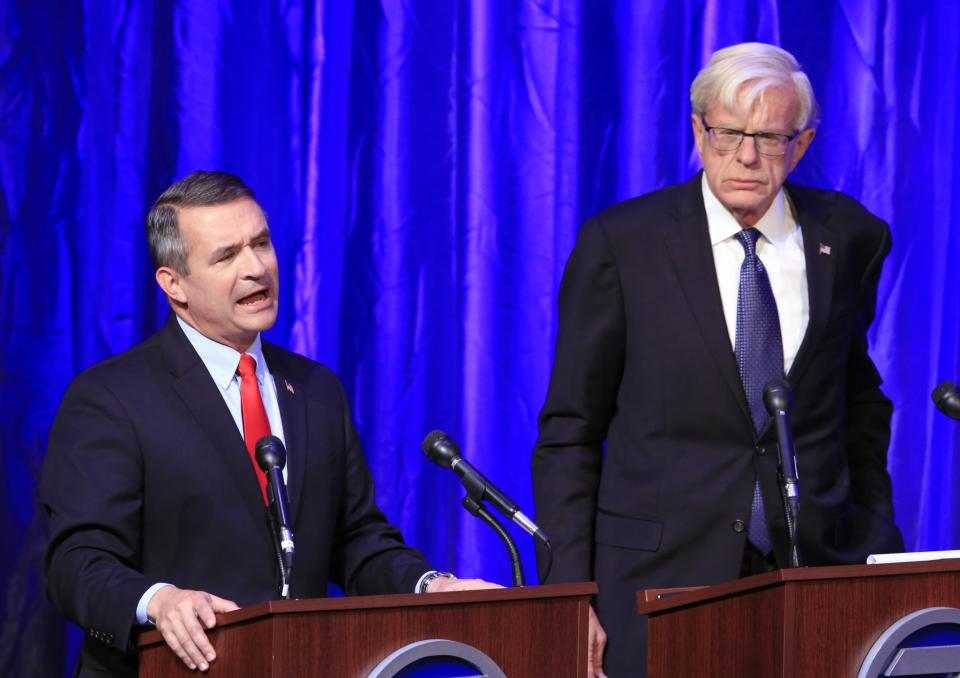Down Ticket #27: The definitive election night guide to the other key races
Down Ticket is Yahoo News’ complete guide to the most fascinating House, Senate and governors’ races of 2016. Coming to you every Tuesday and Thursday until Nov. 8. What you need to know today.
_____
Presidential election? What presidential election? For the last three months, Down Ticket has been obsessing over every race that isn’t Donald Trump vs. Hillary Clinton — and we’re not about to stop now.
As you may have heard, it’s Election Day. Tonight, polling places all across the country will close, and years of spin and speculation will come to an end. We’re finally going to see some results.
The big question on Capitol Hill is how many seats Democrats will gain — and whether those gains will be enough to give them control of one or even both chambers of Congress. Republicans currently have an eight-seat majority in the Senate and a 60-seat majority in the House. But from the beginning, the 2016 playing field has favored the Democrats, with many more Republican-held seats at risk of changing hands.
Can Democrats capitalize? It will be easier on the Senate side. To take back the world’s greatest deliberative body, Democrats will need a net gain of four seats if Clinton wins the White House and five seats if she doesn’t. According to the final race ratings by our expert partners at the Cook Political Report, one Republican seat (Illinois) is leaning Democratic; another six Republican seats (Indiana, Missouri, New Hampshire, North Carolina, Pennsylvania and Wisconsin) are tossups. Only one Democratic seat (Nevada) is too close to call. If you look strictly at the RealClearPolitics polling averages, Republicans lead in enough states to retain a narrow 51-49 majority; if you look at the New York Times’ Upshot forecast — a statistical model that also takes other factors into account — Democrats are slight favorites.
The bottom line: the Senate is going to be very, very close.
The House is a different story. Once upon a time, Democrats thought they might be have a shot at flipping the 30 seats they need to take over. Not anymore. The latest outlook is “a Democratic gain of between 5 and 20 seats, a wide range that reflects the uncertainty of the presidential margin,” according to Cook House analyst David Wasserman, the best in the business.

As the presidential race has tightened over the past few weeks, Wasserman writes, Republicans have appeared to gain momentum, with Democratic strategists now expressing “frustration that they were on the cusp of picking up more than 15 seats” until FBI Director James Comey’s letter about a new batch of Clinton emails “helped bring straggling GOP voters ‘home’ to Donald Trump,” and gave them fresh reason to vote Republican in otherwise “troubled suburban GOP seats.” As a result, Wasserman has moved seven races toward the Republican Party in his final House update.
That said, polling is relatively sparse in House contests. Democrats have the superior get-out-the-vote effort. Thirty Republican seats are still in play — either tossups or leaners — compared to a mere seven for Democrats. And Comey just cleared Clinton of any wrongdoing (again). There could be some surprises tonight.
To help you prepare — and decipher the results once they come rolling in — Down Ticket has put together an hour-by-hour guide to every Senate, House and governor’s race that matters. Break out the chips and salsa. Crack open your beverage of choice. Let the games begin.
_____
6 p.m. ET
INDIANA: Most of the Hoosier State is in the Eastern time zone, and it’s in those parts that the first polls of election night 2016 will close. We won’t start seeing vote counts in Indiana’s hard-fought gubernatorial and Senate battles until an hour later, when the counties on Central time catch up. But fortunately for geeks like us, Indiana’s initial batch of results will include one of 2016’s most fascinating — and potentially revealing — House contests.
Indiana’s Ninth Congressional District — which was redrawn by the GOP in 2010 — should be safe Republican territory. John McCain beat Barack Obama here by 6 percentage points; Mitt Romney routed him by more than 16. And in fact, Democratic polling does show Clinton trailing Trump by 7 percentage points locally. But amid accusations of carpetbagging, this year’s Republican House nominee, businessman and recent Tennessee transplant Trey Hollingsworth, has been having a hard time dispatching Democrat Shelli Yoder, a former Miss Indiana who has built a career as an advocate for people with eating disorders. The latest poll shows Hollingsworth ahead by 2 percentage points overall — with Yoder leading by 3 percentage points among early voters.

Watch this one closely. If Yoder defeats Hollingsworth, it could be an early sign that House Dems will beat expectations. On the flip side, if white turnout surges in Indiana because of Trump, Democrats — from the top of the ticket on down — could be in for a long night.
7 p.m. ET
INDIANA: With statewide voting now wrapped up, we should start to get a sense of what’s happening in the marquee Senate contest between former Democratic Governor and Sen. Evan Bayh and Republican Rep. Todd Young (who vacated his seat in the Ninth Congressional District to compete for higher office). Democrats were ecstatic when Bayh — a member of the Hoosier State’s most prominent political family, with sky-high name recognition — decided to enter the race at the 11th hour, and they assumed that this was one Republican seat that would soon be turning blue. But near-constant revelations about Bayh’s ties to Washington lobbyists and questions about how much time he really spends in Indiana have cut into his early lead, and the fact that Trump has led Clinton in every state poll since the start of the cycle hasn’t helped. The latest poll — the only one conducted entirely in November — shows Young ahead by 5 percentage points, the Republican’s first-ever lead. But most analysts agree that this race is too close to call. Without a win in Indiana, Democrats will have a tough time taking back the Senate.
Also worth watching is the state’s gubernatorial contest between Democrat John Gregg and Republican Lt. Gov. Eric Holcomb. The race looks promising for the Dems. Indiana Gov. Mike Pence was supposed to be running for reelection this fall; then Donald Trump asked him to be his running mate. Pence wasn’t overwhelmingly popular, but at least he was familiar. Holcomb — Pence’s party-appointed, 11th-hour replacement — has struggled to introduce himself to voters, having never competed in a primary. As a result, second-time Democratic nominee Gregg — the former state House speaker — is leading by an average of 3.3 percentage points in the polls, despite Indiana’s rightward tilt.
NEW HAMPSHIRE: The key race here is between Republican Sen. Kelly Ayotte and her Democratic challenger, Gov. Maggie Hassan. This has probably been the most volatile Senate battle of the 2016 cycle: Ayotte led in June and July; Hassan overtook her in August; Ayotte came back in September and early October; Hassan was back on top for a few days mid-month; Ayotte has been ahead, on average, since then — even as the final WMUR/UNH polls shows Hassan up by 4 percentage points.

Tonight’s result is anyone’s guess; it depends who the state’s sizable independent vote goes for. Ayotte struggled to distance herself from Trump for months before finally breaking with him over the “Access Hollywood” videotape; now Trump’s rising Granite State poll numbers seem to be boosting her support. Back-to-back losses in Indiana and New Hampshire would probably put the Senate out of reach for Democrats.
The race to replace Hassan in the governor’s mansion is a coin toss as well. Democrat Colin Van Ostern led in every poll conducted in the second half of October; Republican Chris Sununu — son of former New Hampshire Gov. John H. Sununu and brother of former U.S. Sen. John E. Sununu — has led in every poll since the start of November. Late-breaking Trump voters — Sununu is an unequivocal supporter — could be the deciding factor.
FLORIDA: In a parallel universe, all eyes would be fixed on the Sunshine State Senate contest between incumbent Republican Sen. Marco Rubio and Democratic Rep. Patrick Murphy. But the race hasn’t proven to be particularly suspenseful. Earlier this year, Florida looked like a prime Democratic pickup opportunity. Rubio, then campaigning for the Republican presidential nod, had vowed not to run for reelection; the Republican field was fractured, and the likely Democratic standard-bearer, ambitious 33-year-old Rep. Patrick Murphy, seemed to have all the momentum. But then Rubio reneged on his pledge and reentered the race, and Murphy’s bitter primary fight against firebrand liberal Rep. Alan Grayson — a battle that raised questions about whether Murphy had inflated his résumé — left the young congressman bruised and battered. He hasn’t led in a single poll since June; Senate Democrats recently withdrew funding. If Murphy somehow upsets Rubio on election night, it will mean that Democrats are winning big elsewhere too — likely because of Clinton’s massive Get Out The Vote advantage. But don’t count on it.
Florida’s House races are also intriguing. In the 26th Congressional District, near Miami, Republican Rep. Carlos Curbelo is trying to fend off former Democratic Rep. Joe Garcia. The district’s increasingly liberal, non-Cuban Hispanic demographics are on Garcia’s side — Trump would be lucky to lose here by less than 20 percentage points — but Curbelo has an advantage as well: In 2014, Garcia was implicated in a fake absentee ballot scheme. In the Seventh Congressional District, near Orlando, Republican Rep. John Mica is facing his first real general-election challenger in years: Democrat Stephanie Murphy, a 38-year-old suburban mom, venture capitalist and former Defense Department analyst who announced her bid just one day before the filing deadline and has proven to be a formidable foe. Republicans could lose both seats. At the same time, they’re almost certain to lose the 13th Congressional District, where incumbent GOP Rep. David Jolly is trailing former Republican Gov. (turned Independent, turned Democrat) Charlie Crist.

But those gains could quickly be offset by a pair of Democratic losses. Last year’s court-ordered redistricting carved most of Tallahassee out of the FL-2, making it a whopping 12 points less Democratic and convincing incumbent Rep. Gwen Graham to retire. This year’s Republican nominee, urologist Neil Dunn, is a lock to win Graham’s seat — making this the only guaranteed GOP pickup in the country. The next likeliest GOP flip is in Florida as well: FL-18 (Patrick Murphy’s vacated seat), where disabled veteran Brian Mast leads Democrat Randy Perkins, CEO of a disaster cleanup firm, in multiple private polls.
VIRGINIA: If you want to know how Trump has affected down-ballot Republicans, there may be no better barometer than northern Virginia’s 10th Congressional District, where first-term GOP Rep. Barbara Comstock is technically competing against Democratic real estate executive LuAnn Bennett — but where her real opponent may be the Manhattan mogul atop her own party’s ticket. Thanks to increasingly diverse demographics and Clinton’s well-oiled campaign machine, Trump is on track to lose badly in Fairfax and Loudon counties, potentially dragging Comstock down. Comstock — a former anti-Clinton opposition researcher — dumped Trump immediately after the “Access Hollywood” tape hit the Internet. We’ll find out tonight whether it was enough.
VERMONT: Home to Bernie Sanders, Vermont is typically considered one of the most liberal corners of the country. But this year’s gubernatorial contest appears to be a tossup. Incumbent Democrat Peter Shumlin is retiring, and the pro-abortion-rights, pro-gay-marriage Republican nominee — former state senator, construction contractor and stock car driver Phil Scott — is popular with voters, who twice reelected him lieutenant governor, most recently in 2014 with 62 percent of the vote. Insiders expect Scott to squeak past the Democratic nominee, former state Transportation Secretary Sue Minter.
7:30 p.m. ET
OHIO: The Buckeye State is a key presidential battleground, but don’t expect any down-ballot surprises tonight. Early on, the Senate race between incumbent GOP Sen. Rob Portman and former Democratic Gov. Ted Strickland seemed destined to be a nail biter; Strickland led — narrowly — in nearly every survey taken before the start of the summer. But that was a long time ago. Boosted by tens of millions in outside spending, a huge fundraising advantage and several key union endorsements, Portman has run what Republicans describe as a pitch-perfect down-ballot campaign, reaching out to split-ticket swing voters while refusing to let Trump define him. (Like Ohio Gov. John Kasich, he declined to attend the Republican National Convention in Cleveland.) As a result, Portman took the lead in June, and he’s only pulled further ahead since then; average together the latest polls and he’s currently clobbering Strickland by 18.3 percentage points.

NORTH CAROLINA: If you’re looking for down-ballot drama, North Carolina is the place. Forget about the Tarheel State’s impossibly tight presidential contest, which could decide the White House; both the Senate battle between GOP incumbent Richard Burr and Democratic challenger Deborah Ross and the gubernatorial face-off between Republican Gov. Pat McCrory and Democratic rival Roy Cooper are too close to call as well.
Ross, a former state Representative and past executive director of the North Carolina ACLU, wasn’t supposed to be this year’s Democratic Senate candidate; D.C. Dems would have preferred the popular Cooper. But Burr has run a flat-footed campaign — most recently, he joked about gun owners shooting Clinton — and a huge influx of Democratic resources and field staffers have helped Ross remain competitive. Though she hasn’t topped Burr in the polling averages since Oct. 8, she’s still well within striking distance.
In the governor’s race, McCrory led in nearly every early poll, but state Democratic Attorney General Cooper pulled ahead in August and since then has topped his GOP rival in all but a handful of Republican-leaning surveys (including every poll conducted from Oct. 27 on). McCrory could still prevail — his handling of Hurricane Matthew was widely praised — but backlash against North Carolina’s ultraconservative legislature, and in particular House Bill 2, a divisive transgender bathroom law that has driven businesses away from the state, has been boosting Cooper’s chances.
If Democrats win both of these races, they’ll likely have the Clinton campaign to thank. Brooklyn has flooded the zone with cash, organizers and top surrogates; Barack Obama, Michelle Obama and Bill Clinton have all visited in recent days. The Trump campaign, meanwhile, hasn’t invested nearly as much. This is crucial because, as FiveThirtyEight’s Harry Enten points out, “There are very few swing voters in North Carolina, so the race is all about turnout.” A sweep here would prove that the ground game still matters.
8 p.m. ET
MISSOURI: This may be the strangest state of the entire election. On the presidential level, Trump seems like a sure thing, having led in every single poll since July. But down-ballot Democrats are doing a lot better than Clinton, who is particularly unpopular among the Show Me State’s white, working class, increasingly conservative electorate. For much of the summer and fall, Attorney General Chris Koster, a Republican turned Democrat with tens of millions in the bank, was trouncing rookie Republican Eric Greitens, a veteran of the wars in Iraq and Afghanistan, in the gubernatorial polls. The gap has narrowed in recent days, but it’s still anyone’s race.

The Missouri Senate contest may be even more surprising. Very few people predicted that the battle between GOP incumbent Roy Blunt and Democratic challenger Jason Kander would prove pivotal this fall. Obama nearly carried Missouri in 2008, but since then, its politics have drifted rightward; Mitt Romney trounced the president by 10 percentage points in 2012. Today, six of Missouri’s eight U.S. House members are Republican, and the GOP enjoys comfortable majorities in both chambers of the state legislature.
And yet the state’s sole November survey puts Kander — a 35-year-old Afghanistan vet who currently serves as secretary of state — ahead by 1 percentage point. The reason: He’s run a better campaign.
In an anti-establishment year, Kander’s goal has been to make Blunt — a 66-year-old who spent seven terms in the House before winning an open Senate seat in 2010 and whose wife and three children all work lobbyists — look like part of the problem: an old, self-serving, business-as-usual politician. Kander, in contrast, has been touting himself as a different kind of Democrat — one who has bucked his party by supporting a balanced-budget amendment to the Constitution, opposing the Iran deal and rejecting the president’s executive actions on immigration. Oh, and in case you haven’t caught one of the most-viewed and talked-about political spots of the cycle, Kander is also the kind of Democrat who can assemble an AR-15 rifle with a blindfold on.
For Democrats struggling to figure out how to win in red states in the Age of Trump, Kander and Koster could point the way — provided they come out on top tonight.
PENNSYLVANIA SENATE: This one is simple: If Democratic challenger Katie McGinty, a former state and federal environmental policy official, doesn’t defeat incumbent GOP Sen. Pat Toomey, Democrats will not take back the Senate. McGinty has the wind at her back, with the big statewide investments from Clinton and the rest of the Democratic Party; a deeply conservative opponent who has struggled to divorce himself from Trump, who is a toxic figure among the well-educated, well-off, moderately Republican Philadelphia suburbanites set to decide the state’s election; and polls that have shown both Clinton and McGinty herself ahead by a couple of percentage points since the start of November.
ILLINOIS SENATE: Incumbent Republican Sen. Mark Kirk is toast; Democratic Rep. Tammy Duckworth, who leads Kirk by 13.3 percentage points in the RealClearPolitics polling average, will almost certainly be taking his place on Capitol Hill next year. This is the only state where Democrats are all but guaranteed to pick up a Senate seat.
HOUSE RACES IN NEW JERSEY, PENNSYLVANIA, ILLINOIS, TEXAS, NEBRASKA AND KANSAS: Once the polls close in these states, we’ll start to get our first real sense of how the night is shaping up for House Democrats. If Democratic Rep. Brad Ashford loses to Republican challenger Don Bacon in Nebraksa’s Second Congressional District — one of only of two Democratic-held tossups this year, according to Cook — things could be heading south. If Democrat Pete Gallego unseats GOP Rep. Will Hurd in TX-23 — a border district that encompasses the suburbs of San Antonio and El Paso — it could suggest that high anti-Trump Latino turnout will lift Democrats elsewhere as well. And if Democrats prevail in key tossup suburban districts such as NJ-5 (Bergen County), PA-8 (Bucks County), and IL-10 (Lake Shore), it may hint that college-educated Republicans have broken for Clinton & Co. in record numbers.

But the two races that Down Ticket will be watching most closely are PA-16 and KS-3. Like IN-9, these “Lean Republican” contests could be canaries in the electoral coal mine; if Democrats overperform here, they’re likely to overperform nationally.
As for PA-16, nonprofit consultant Christina Hartman — a political neophyte — wasn’t supposed to have a shot in this right-leaning Lancaster-area district. When Hartman’s Republican rival, state Sen. Lloyd Smucker, defeated his April primary opponent (who also happened to be his second cousin) by nearly 10 percentage points, the fall election was widely seen as a foregone conclusion.
But what was once a safely Republican district is no more. In July, Cook Political Report changed its race rating to Likely Republican — and last month, the outlet went one step further, putting PA-16 into the Lean Republican category.
This shift is partly the result of structural forces; the 16th’s borders were redrawn after 2010, making it less conservative than before. But the real reason Down Ticket will be watching PA-16 closely is Trump. The city of Reading is nearly 60 percent Latino; Chester County is full of college-educated whites; and Lancaster (home of the Amish) is deeply religious. If Latinos turn out in droves to vote against Trump — and if white suburbanites and Christian conservatives either stay home or defect in unusually high numbers — we’ll see the effects here first.
Similar dynamics are at work in KS-3. This year, Kevin Yoder is running for reelection against Democratic businessman Jay Sidie, a political novice. Yoder should be winning by the same sort of comfortable margin he enjoyed 2014, when he demolished former Democratic state Sen. Kelly Kultala with 60 percent of the vote. But the latest polls say otherwise.
Trump could be the problem. KS-3 is packed with college-educated white voters. And while Yoder initially preferred Marco Rubio, he has backed Trump ever since the Manhattan mogul clinched the GOP nomination, refusing to break with him even after the “Access Hollywood” video upended the campaign.
In 2012, Romney won KS-3 by nearly 10 percentage points. But every poll released this cycle — Democratic and Republican — has shown Clinton ahead of Trump. The most recent survey — the only one in the field after the “Access Hollywood” kerfuffle — gives Clinton a 10 percentage-point lead.
“I think there’s a lot of worry that Republican turnout could crater,” Kyle Kondik, who studies House races for the Center for Politics at the University of Virginia, recently told the Kansas City Star. “And those are votes that not only Trump loses, but also someone like Yoder loses.”
9 p.m. ET
WISCONSIN SENATE: Of the 30 public polls released since the start of the 2016 cycle, only one, from early October, has showed incumbent GOP Sen. Ron Johnson leading the man he unseated six years ago, Democrat Russ Feingold; the other 29 have given Feingold the edge. On top of that, a Republican Senate candidate hasn’t won Wisconsin during a presidential year since the GOP wave of 1980; Clinton currently leads Trump statewide by an average of 6.5 percentage points; and Johnson’s record is far more conservative than the state as a whole. But of all of this year’s tossup Senate races, Wisconsin still has the most potential to surprise the pundits. Feingold has slipped in the recent polls — his average lead is now 2.7 percentage points, down from 6.8 on Halloween — and the Badger State’s most respected polling firm, Marquette, now says there’s only single point separating the two candidates. Pay close attention to tonight’s returns — without Wisconsin, Democrats won’t take back the Senate.
HOUSE RACES IN NEW YORK, WISCONSIN, MINNESOTA and MICHIGAN: In large part, congressional contests reflect the presidential contest; down-ballot candidates tend to rise or fall on the fortunes of the White House wannabes atop their party’s ticket. So it could be that Democratic gains in suburban and/or heavily Latino House districts earlier or later in the evening will be tempered, in the heart of election night, by Republican victories in areas that tend to favor Trump: the industrial Midwest and the whiter, more blue-collar pockets of the Northeast.
The 9 p.m. hour in particular will put this theory to the test as results from competitive — or once-competitive — House races in New York, Wisconsin, Minnesota and Michigan start to come in. Some of these contests already seem like lost causes; as Cook’s David Wasserman recently noted, “Democrats were once ecstatic about their candidates in southern Michigan and northeast Wisconsin, but Trump’s appeal in MI-07 and WI-08 has taken those races off the board.”
Down-ballot Dems are also having trouble in New York. A new Siena Research Institute poll found Trump ahead by 14 points in Utica’s NY-22, enough to give GOP Assemblywoman Claudia Tenney the edge. In NY-24 (Syracuse), GOP Rep. John Katko is clobbering his Democratic rival, Colleen Deacon, by 23 points. And on Long Island, Trump’s late rebound has put one GOP seat out of reach for Dems (NY-01, where Rep. Lee Zeldin, an early Trump backer, has surged to a 21-point lead, according to Siena) and another Democratic-held seat at risk (NY-03, where Siena found that former Nassau County Executive Tom Suozzi’s lead has shrunk from 16 points to 7 points as Clinton’s lead has narrowed to one point).
![Assemblywoman Claudia Tenney and Rep. John Katko. (Photos: Mike Groll/AP [2] )](https://s.yimg.com/ny/api/res/1.2/8seVbbQMH_h7VrAaRBDvow--/YXBwaWQ9aGlnaGxhbmRlcjt3PTk2MDtoPTQ3Nw--/https://media.zenfs.com/en/homerun/feed_manager_auto_publish_494/fb939207c90b6df3f8c92739545ee2b8)
The tipping point races will probably be in Minnesota (MN-2, MN-3, MN-8) and Michigan (MI-8). Win in the upper Midwest and House Democrats can probably expect to gain 15 or more seats when the dust settles; lose, and they probably won’t pick up more than 10 overall.
ARIZONA: Desperate to find out whether John McCain can hang onto his Grand Canyon State Senate seat for yet another term — and whether Democrats can retain control of the sprawling House district (AZ-1) being vacated by his challenger, Democratic Rep. Ann Kirkpatrick? Tune in at 9 p.m. ET! (Spoiler alert: McCain leads Kirkpatrick by 10 percentage points, on average, and the GOP’s House nominee, Pinal County Sheriff Paul Babeu, has so much baggage that he’s unlikely to defeat former State Sen. Tom O’Halleran — especially in an area with high populations of Latinos and Mormons, two Trump weak spots.)
10 p.m. ET
NEVADA: The Silver State could decide control of the Senate — and Democrats seem to have the late-breaking advantage. For much of the race to replace retiring Democratic Senate Minority Leader Harry Reid, Republican Rep. Joe Heck, a physician and brigadier general in the Army reserves, seemed like the favorite; he led Democratic Attorney General Catherine Cortez Masto in every poll conducted between July and early October, except for one. (That one was a tie.) Then Trump’s “Access Hollywood” video dropped — and Heck, who had resolutely supported his party’s nominee up until that moment, got flummoxed. First he revoked his endorsement; then he equivocated; then he said his presidential vote was a private matter; then he said he was still making up his mind. Trump’s white, working-class fans (and there are plenty of them in Nevada) booed; Latinos and moderates never bought Heck’s sudden (and somewhat confusing) conversion. It was the worst of both worlds, and Cortez Masto, who would be America’s first Latina senator, pulled ahead in most subsequent polls, including the two released this month. But with the race still close — her lead currently averages 0.4 percentage points — the real deciding factor will be turnout. The early voting data, according to ace Nevada political reporter Jon Ralston, favors Cortez Masto (while virtually ensuring that Clinton will defeat Trump statewide). To win, Heck would have to defeat his Democratic rival by 5 percentage points or more in today’s voting — not impossible, but a tall order all the same.
Meanwhile, Ralston says that Reid’s early voting turnout machine — and heavy Latino turnout in particular — is also likely to net a pair of Nevada House seats for the Dems: NV-03, Heck’s current seat, and NV-04, where Republican Cresent Hardy is facing a stiff challenge from Democratic State Sen. Ruben Kihuen.
11 p.m. ET
CALIFORNIA: It’s not every day that you get to watch in real time as one of the two major political parties basically goes extinct in America’s most populous state. But that’s exactly what could happen when California goes to the polls today.
The marquee contest is the one between Rep. Darrell Issa, the Republican incumbent in California’s 49th Congressional District, just north of San Diego, and retired Marine Col. Doug Applegate, his Democratic challenger. Issa was first elected to Congress in 2000, and since then, no Democrat has come within 16 percentage points of defeating him. Safely ensconced in his seat — he’s also one of America’s wealthiest politicians — Issa developed a reputation in Congress as a partisan brawler, using his perch as chairman of the House Oversight Committee to torture the Obama administration at every turn.

But now, with Applegate attacking him for supporting Donald Trump and internal polls showing a tied race, Issa is flailing, embracing Obama and saying he would have signed on as one of Clinton’s advisers if asked.
And Issa isn’t the only California Republican in danger. In the Modesto area, third-term Rep. Jeff Denham is struggling against Democrat Michael Eggman, the same beekeeper he beat just two years ago by 12 points (even as a majority of Denham’s constituents voted for President Obama). In the Central Valley’s 21st District, the national Democratic Party is spending big money to tie Rep. David Valadao to Trump, even though the Republican has said for months that he won’t support his party’s nominee. In the 25th District, north of Los Angeles, freshman Rep. Steve Knight — a top target for national Democrats — was recently named California’s most endangered incumbent. And a recent Politico analysis showed that Democrats — who already control both chambers of the California legislature — were likely to gain a supermajority in the state Assembly and come within striking distance in the state Senate.
Overall, Latinos now outnumber non-Latino whites in California, and their numbers are growing rapidly in districts once thought to be safely Republican. Thanks to robust Democratic voter registration efforts, Republican Party registration has fallen below 27 percent statewide, down from 30 percent in 2012. As a result, statewide Democratic turnout would have improved this year by an average of 5 percentage points over 2012, no matter who was on the ballot. Trump, with his anti-immigrant rhetoric, has simply made matters worse.
None of which will be enough to put Democrats over the top in the U.S. House, of course. Even so, a few extra Latino-driven wins in the Golden State could offset Democratic losses in the Midwest and Northeast and foreshadow future elections in which the accelerating diversity of the U.S. electorate puts some new Republican districts in play.
____
Portions of this guide consist of updated material from earlier Down Ticket columns.
_____
Countdown
_____




